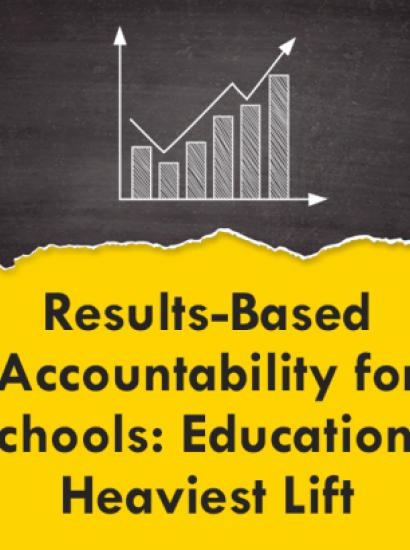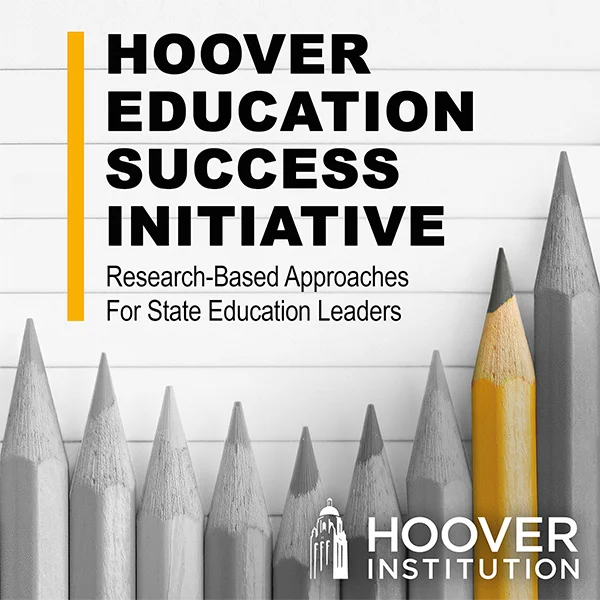- Education
- Reforming K-12 Education
Recommendations
- ✏1 As required by the Every Student Succeeds Act (ESSA), states should resume school-level accountability as soon as the pandemic is substantially under control, most students are regularly attending school or can be assessed remotely, and reliable data are available, including achievement and growth data. The target should be the end of school year 2021–22.
- While retaining academic achievement and growth at the core of evaluating school performance, state leaders should use the present accountability “pause” to consider what additional measures are needed—and how to develop them to a level of reliability and validity suitable for inclusion in accountability regimes. Attendance and absenteeism, for example, seem more important than ever due to the pandemic. Also highly desirable are additional measures of student learning and school effectiveness and equity as well as children’s physical, mental, and emotional well-being.1 Few such measures yet qualify for summative accountability calculations, so further work is needed. The federal recovery funds now beginning to flood into states, districts, and schools may be deployed to underwrite some of this important development work.
- Interim step: Measures that don’t yet qualify for accountability can already provide valuable formative feedback for teachers and education leaders at every level.2
- Incorporate parents and community leaders in developing performance standards for schools—and build wider coalitions of support for accountability itself. Public education is necessarily a fusion of professionalism and expertise on the one hand, with populism and adaptation on the other. An example would be setting promotion criteria for children from grade to grade, from elementary to middle school, and from middle to high school.
- ✏2Deploy available resources, including the federal stimulus and recovery funds, to boost schools’ (and districts’ and states’) capacity to deliver stronger achievement for all students, to intervene effectively in troubled schools, and to create high-quality alternative learning opportunities for students who need them. Many state agencies need to augment their own capabilities even as they gauge and then strengthen the capacity of districts and schools to make needed improvements in performance.3 Standards are urgently needed here, too; one might think of them as “professional standards” against which components of the education system—from curricula to classroom performance to organizational efficiency—may be gauged.
- Going forward, consider two forms of consequences for persistently low-performing schools: effective interventions and providing other options for students.4
- Look beyond ESSA to the next era of school accountability without losing sight of its primary purposes: strengthening achievement, accelerating growth, fostering equity by narrowing gaps, providing students and parents with educational opportunities that meet their needs, and guaranteeing taxpayers the maximum return on their investment in public education.
Today’s Challenges
Results-based school accountability is the linchpin of education-reform policy in the United States and has been for at least two decades. This follows from the expectation that schools are responsible for the extent to which their pupils learn what the state expects them to. By including achievement growth with proficiency in estimates of school results, schools with disadvantaged pupil populations can be evaluated more fairly. Adjustments may be made for other important variables such as high levels of student mobility. And other metrics of school performance, when valid, may also be factored into such calculations and judgments.
✏3 Yet results-based accountability has never been popular among educators, many of whom view it as embarrassing, punitive, a rejection of their professionalism, and far too cramped a definition of school quality and student learning. Understandably, they often bridle at attempts from outside to alter or intervene in their schools (even when low performing)—and the more forceful or disruptive the intervention the greater the resistance. That school accountability has often depended heavily on test scores (which were also sometimes used for evaluating individual teachers) has fed further resistance and a testing backlash. Many are concerned that schools (and districts and states) often lack the resources and capacity to make improvements the need for which is made clear via the accountability metrics. Over the past year, shutdowns forced by the coronavirus pandemic have created huge additional challenges for delivering instruction while also causing large data gaps.5[5]
✏4 Accountability need not be confined to schools; it may also apply to individual students, educators, school systems, even to entire states. But at least since the enactment of No Child Left Behind (2002)—and earlier in some states—school-level accountability has been the main focus of federal law and kindred state efforts. It’s long been seen by most advocates as a tripod consisting of academic standards; assessments (mostly standardized tests) to determine how well those standards are being attained; and “consequences” for schools depending on whether their pupils meet, exceed, or lag behind the standards. Today, however, many note that a well-conceived accountability system must also attend to the capacity of schools, districts—and states themselves—to rectify the shortcomings and implement the consequences that the “tripod” sets forth. (“Capacity” is not itself an outcome, but in its many forms capacity may be a precondition for improving school outcomes. It’s not just about resources, either. There’s an impressive growing field of “improvement science.”6)
Along with much else in the lives of Americans, the COVID-19 pandemic has interrupted school accountability in several ways: dearth of assessment data, spotty pupil (and teacher) attendance, weak or nonexistent metrics for gauging the impact of virtual schooling, and the widespread sense that schools ought not be held to account for results when so many factors that contribute to those results are beyond their control.
That’s no reason to discard the accountability baby, however, just because it’s sitting in a puddle of murky water that we’re eager to drain off. This baby needs caring for!
Uncertainty Plus Urgency
✏5 A convincing case can be made—and many states have already moved to do this—that schools need an “accountability holiday” due to the coronavirus interruption. But how long should that holiday last and when will it be reasonable—and feasible—to resume accountability? That’s not just because it is required (for Title I schools) under ESSA. A more fundamental and enduring reason to resume it is that if American schools ceased indefinitely to be held responsible for their outcomes, our education system would revert to having no consequences for failure nor any reward for success. There’d be little reason to rectify shortcomings, to close achievement gaps, to accelerate the pursuit of excellence, or systematically to remedy major learning losses. Schools would be judged by their inputs, their promises, their programs and facilities, and what people say about them rather than by their success in moving their pupils to readiness for successful participation in our society, our economy, and our polity—and in their own communities. Were that to happen, ancient gaps would remain, failings would be hidden, and many children would be ill served, as would their families and those whose taxes pay for their schools.
✏6 It’s urgent that state leaders not turn their backs on school accountability, not when so many schools and students have so much catching up to do. All the challenges that have long faced US education are amplified when tens of millions of children have been trying to learn at home and are not physically present in school. They may also be present online only intermittently. And it’s already well known that the greatest learning handicaps—and most severe learning losses—are befalling our low-income and Black and Brown children, girls and boys who were already the focus of equity concerns and policy priorities.
What We Know
Accountability works. Which is to say, both experience and research have shown that states and nations with results-based accountability regimes operating in their primary-secondary education systems show stronger student achievement.7[7]For it to work well, however, these requisites must be in place:
- Rigorous academic standards that clearly set forth the knowledge and skills that children in a state should acquire and that schools should systematically impart to them. Every state now has some form of such standards at least for math and English language arts. Most states also have standards for other core subjects.8 Sometimes these are organized by grade level or grade band, sometimes by individual courses. But they are not always rigorous, well organized, and easily applied by curriculum developers, teacher educators, test-makers, or classroom instructors.9
- Quality assessments and other metrics. Standards are of little value without reliable means of gauging how well individual students, groups of students, schools, and school systems are doing at meeting (or exceeding) those standards. Toward that end, metrics are necessary. These most commonly take the form of standardized assessments, which federal law requires for reading and math in grades three through eight and for science. Many states have developed their own standards-based assessments in other subjects and grade levels, including end-of-course exams, “reading guarantees,” and high-school exit exams. Many states are also moving beyond the “pass/fail” mode under which one is either “proficient” or not. It’s important, going forward, to deploy a range of performance levels, much as the National Assessment of Education Progress (NAEP) program does (“basic,” “proficient,” “advanced”) and as many states do when awarding schools grades from A to F or stars from one to five.
- No matter how it’s done, standardized testing is an incomplete measure of the skills and knowledge that students acquire—and should acquire—in school, much less of many other important attributes and qualities that we want schools to impart to their pupils (e.g., character, citizenship, tolerance). Hence, much work is underway—and should continue—to develop sound means of monitoring other valued school outcomes. Once proven, such metrics may be incorporated into school accountability regimes.
- ✏7 Consequences. This is the hardest part, both politically and operationally. It’s hard politically because nobody welcomes being told—or forced—to change, so the pushback is often intense. But it’s also hardest operationally because changes made under the heading of “consequences” don’t always yield the desired improvement. The most frequent consequence for a low-performing school is an effort by the district or state to “turn it around.” But the track record of such interventions is mixed.10 Adding to the challenge is that the forms of intervention that tend to work best are the most drastic or severe—such as replacing a school’s leaders and instructional team or outsourcing it to another organization to run—and those are of course the most fiercely resisted.
Intervention isn’t the only possible consequence, however. A chronically low-performing school may be shut altogether, or its students may be given “exit visas” and the means to attend different schools. Yet any effort to close a school inevitably encounters fierce resistance from those whose school it is—parents, teachers, alumni/ae, neighbors, etc.—and the alternative schools that are accessible to its pupils may not be any better.
It’s also important to note that “consequences” aren’t always negative or disruptive. Accountability systems also yield recognition, accolades, and sometimes other rewards for successful schools and those who lead and teach in then.
Capacity Is Needed, Too
It’s not part of accountability per se, but any well-functioning accountability regime needs its key players to possess the know-how, the means, and the leverage to make bad schools get better and new schools succeed. This encompasses so many different forms and applies to so many levels of the education system that we cannot do it justice here. Suffice to say, the designers of responsible accountability regimens should also be attentive to the need for schools (and districts and states) to possess the human, fiscal, and political wherewithal to discharge their responsibilities successfully, including continuous improvement when results are good and the ability to diagnose and remedy shortcomings when necessary. For this to work well, they’ll need also to develop, apply, and enforce the kinds of professional standards that we take for granted in hospitals, transit systems, airline operations, engineering firms, and securities markets.11
Back to ESSA—and Beyond
In time, we assume, the present accountability “holiday” will end and states and districts will return to the requirements of the Every Student Succeeds Act. This pause affords state leaders an excellent opportunity to make revisions in their accountability plans, mindful of important changes in American education (and American life) that have taken place since those plans were prepared. It’s also an opportunity to begin thinking beyond ESSA to the kind of accountability system that might better serve US schools, communities, and states going forward. As we consider that possibility, we find that most of the features we would like to see in the future could actually be incorporated into present-day practices, both within and in parallel to ESSA.
We recommend incorporating a somewhat changed assessment regimen and fresh thinking about consequences. Tomorrow’s accountability systems should be geared less to short-run gauges of “proficiency” and more to students’ true readiness for college, career, citizenship, and adulthood. Here are the essential elements:
Assessment
- Kindergarten readiness. Although this measure ought not be used for school accountability, entering kindergartners should be assessed on their readiness to succeed in school, including but not limited to their preparedness to undertake reading and arithmetic. Such information creates an essential baseline for all that follows.
- ✏8English language arts (ELA) and math prowess. States should continue to test students in ELA and math. It would be better to start in grade two, rather than three, and to continue through grade eight, although we know that accurate growth estimates can be based on alternate-year testing and states may prefer to lighten the annual testing burden in light of the additions recommended below.
- End-of-course exams. States should add capstone (end-of-course, or EOC) exams in other core subjects during both middle and high school, aligning these with high-quality curricula in those subjects, including career and technical subjects as well as the traditional academic core.
- Diplomas that mean something. With EOCs in place for key high school courses, requiring that they be passed at a satisfactory level becomes an excellent way of ensuring that diplomas attest to actual accomplishment.
For accountability purposes at the high school level, states should weigh a school’s success in getting all students to the passing level on the EOCs (and thence to graduation) and also its success in getting as many as possible to the college/career readiness threshold and beyond.
✏9 Test scores, however, are not comprehensive indicators of school performance. Many states have already included gauges of school “quality” or “climate” in their ESSA plans.12 These are often based on surveys of school staff, students, and sometimes parents. A widening array of such surveys and other “school climate” indicators is becoming available, as are gauges of students’ social and emotional well-being.13 These must be deployed with caution, as most have not yet been demonstrated to be valid and reliable and some are vulnerable to manipulation. We encourage states to consider their potential as well as their limitations. We also encourage inclusion of more objective indicators such as student (and staff) attendance, chronic absenteeism, and student safety. Where an indicator has not yet been proven sufficiently reliable or valid to incorporate in formal accountability algorithms, it may yet be included in a school report card as an information item.
Analysis and Reporting
Achievement and growth should remain the core criteria by which school performance is evaluated. We recommend continuing with ESSA-style data gathering on student learning, based primarily on external exams developed by states and aligned with their academic standards. Results should continue to be disaggregated by student group and reported at the school, district, and state levels, as should growth whenever that can be calculated. States should continue to participate in the National Assessment and should demand state-level NAEP data for twelfth grade as well as fourth and eighth grades. Schools should continue to be assigned ratings based on their performance, and easily grasped information about that performance should be made public on websites, report cards, and dashboards.
Consequences
✏10 What to do about troubled schools? A range of consequences should be considered. Truly weak schools cry out for top-to-bottom overhauls. Schools with some shortcomings may need additional resources, professional development, or expert consulting. “Okay” schools may need help in developing and applying “continuous improvement” or “good to great” stratagems. In other situations and settings, the wisest course of action may be to rely on informed choices by parents to place their children in better schools. No single approach is foolproof, but each is better than leaving ineffective schools untouched with students confined in them.
Conclusion
We urge state leaders to recommit to results-based school accountability adapted to a post-pandemic era, with greater focus than ever before on equity as well as excellence, on growth as well as achievement, on the swift rectifying of recent learning losses as well as further gains, on the individualization of student progress, and on college/career readiness along with citizenship as the foremost goal of K–12 schooling.





















